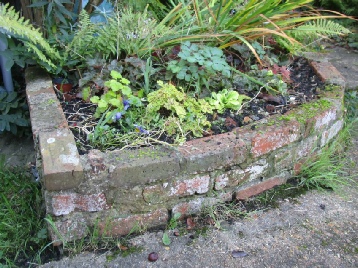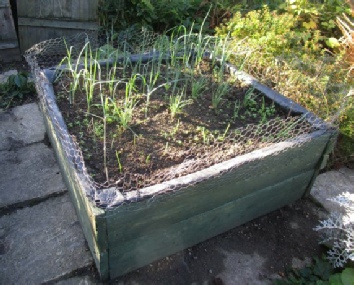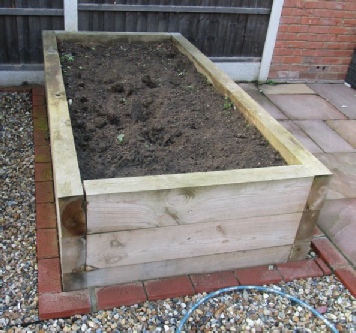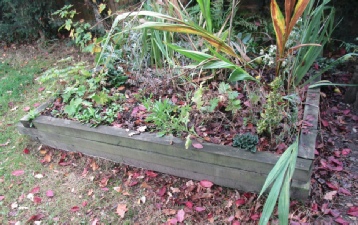





Raised Beds
Fashion plays a part, even with ‘growing stuff’. We may be wrong, but it seems that raised beds are ‘in’ and appear to be springing up all over the place, so why create such a bed, how do you do it and what are key things to think about. You will no doubt find this information all over the Internet, as is true of most gardening matters, but as our role on these pages continues to be to encourage our readers to think further afield, especially beginners to garden life, we’re going to venture out into this area in a more personalized way than you might find elsewhere. It’s an area that we’ve never been in before on these pages but it is an area with which we have had long-
.

An early version brick raised bed
The first thing to say is that unless you have a friend getting rid of materials or you’ve just bought an old house and have materials on hand, it is going to cost more than just growing traditionally with ground-

Scaffold boards painted plus wire ‘fence’ to house leeks and onions
Why Raised Beds?
They aren’t for everyone because many of us like the simple straight forward ground-
First, they create a very distinct border and, being raised, I have found they brings weeds to my notice much quicker than in my traditional beds, so I end up with cleaner beds.
Second, they can create an interesting landscaping scenario and beds can be different depths with paths between to create interest.
Third, they tend to make one far more thoughtful about the soil. If the soil in your garden is naturally acidic and you want to have some plants that dislike such soils, it is relatively easy to create a limited-
Fourth, raised beds also lend themselves to extensive use of trailing plants, so at the appropriate time of the year trailing lobelia and trailing nasturtiums or even trailing geraniums can be seen hanging above path level. The list is endless, and the results create a soft and fascinating mixture around the garden.
Fifth, and this is for those of us of more mature years, a raised bed means you don’t have to bend down so much. These days garden centres seem to have lots of growing tables or growing troughs for growing plants at waist level, but if you have plenty of old materials on hand your creativity will not doubt bring about your own designs.
Sixth, growing different plants in different areas can create interest. For example, our older brick raised beds are for flowers. My more recent experiments in timber are all for vegetables although I was given as a birthday present a ‘wild flower growing mat’ which is tempting me to give over a recent higher raised bed to wild flowers in the midst of everything else. If it works I anticipate this mini-
Seventh, there is also a challenge about raised beds, especially the higher ones I think, as to how much you can grow in it, though it doesn’t have to be more than a single board bed. There was a challenging idea that appeared over the horizon of gardening creativity not too long ago and one of my family prodded me with it as a recent birthday present, a book entitled, ‘Grow all you can eat in 3 square feet’. Hmmm! We will see what we will see!
How to do it
Fairly simple really, create a box or larger rectangular shape to fit the space or spaces you have available. Obviously you’ll think about location and so if you put one against a north facing wall or fence, you’ll probably end up putting shade loving plants in it. For growing veg you’ll locate where the sun shines. The two key things to think about are a) the material you use and b) the soil etc. you put into it.

A larger timber bed in its early days

Tucked away in a corner, a raised bed made from old fence posts
a) Construction materials
The obvious materials are timber or bricks or blocks. Decades back I created brick raised beds and these are still exactly as they were first constructed – although obviously weathered somewhat; they have done us well. One or two of them have housed the same bush plants and therefore have not been replenished, while others of them have had various plant changes and along with them fresh soil and compost.
When we move into the realm of timber there are a number of considerations. I ‘inherited’ an allotment with raised beds made from scaffold boards which have performed their task for about five years. Having said that many of these boards are rotten along the bottom two or three inches and so I have been removing them, burning some and recycling some in creating smaller deeper beds. I have also come across someone who moved into a house with a nice garden with raised areas created by larger timbers and all of those timbers have gone rotten on the back side and will need replacing. Preservation is the main problem with the use of timber.
The experts advise the use of oak or sweet chestnut which are hard and dense and only then start talking about larch or pine and the need to have them pressure treated. Obviously all of these are more expensive than getting hold of secondhand scaffolding boards. Pressure treated timber means the preservative goes deep into the wood which is obviously better than you simply painting it with preservative. Railway sleepers that have tar on them are messy but other baulk timbers that are treated are ideal. If your garden is neat, tidy and the joy of your life then appearance is important, and quality treated timber will be your choice. I have never been so particular and so have used old fence posts that had been originally pressure treated and now, more recently, old scaffold boards which I have painted with preservative and have lined the insides of deep beds with plastic lining, being a belt, braces AND string sort of person who is not particularly concerned with appearance, more with keeping the bed functional.
b) Soil
It rather depends on what you have got or can get hold of because this can be another purse-
And so, there it is, a different way of gardening with pros and cons but which can be fun creating and even more fun as you develop your beds and watch them mature. Perhaps one final point needs making. If you have cats or your neighbours have cats, a brand new bed seems to attract them and suggest to them that here is a place to deposit their own waste. To counter this, I have either filled the bed rapidly with plants or put up a shallow ‘fence’ of chicken wire which appears to have deterred their earlier efforts. But don’t be put off by such things. Persevere and enjoy!